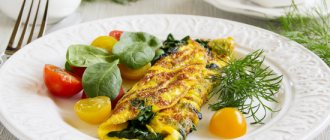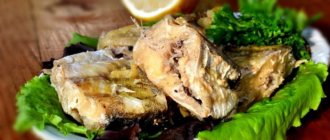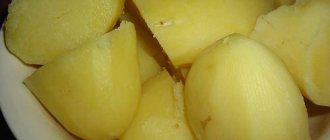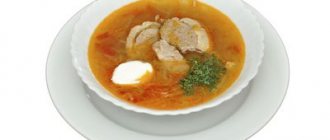Ukha is a traditional Russian first dish. In ancient times, fish soup was the name given to any first course, regardless of the basis on which it was prepared. Starting from the 18th century, fish soup began to be called the first dish prepared exclusively on the basis of fish.
In modern cooking, ukha is considered a unique fish dish. Depending on the method of preparation and its contents, this dish is classified into different types. There are many recipes for preparing this dish, which allows you to significantly diversify the diet of any person.
Related Products
Chili soup (57 cal) Carrot coriander soup (100 cal) Lentil soup (54 cal) Vegetable soup (41 cal) Clear soup (8 cal) Chicken soup (60 cal) Potato soup (63 cal) ) Mushroom soup (51 cal) Tomato soup (43 cal) Bean soup (74 cal) Turtle soup (53 cal) Onion soup (44 cal) Noodle soup (35 cal) Beef soup (50 cal) .) Pea soup (67 cal) Vegetable pasta soup (44 cal) Broccoli soup (60 cal) Homemade soups (22 cal) Turkey soup (38 cal) Cream soups (52 cal) Meat soup (50 cal) Oyster stew soup (40 cal) Chinese soup (33 cal) Shark fin soup (46 cal) Cheese soup (76 cal)
Ear recipe. Calorie, chemical composition and nutritional value.
Nutritional value and chemical composition of "Ukha".
The table shows the nutritional content (calories, proteins, fats, carbohydrates, vitamins and minerals) per 100 grams of edible portion.
| Nutrient | Quantity | Norm** | % of the norm in 100 g | % of the norm in 100 kcal | 100% normal |
| Calorie content | 31.1 kcal | 1684 kcal | 1.8% | 5.8% | 5415 g |
| Squirrels | 2.1 g | 76 g | 2.8% | 9% | 3619 g |
| Fats | 0.2 g | 56 g | 0.4% | 1.3% | 28000 g |
| Carbohydrates | 5.2 g | 219 g | 2.4% | 7.7% | 4212 g |
| Organic acids | 0.1 g | ~ | |||
| Alimentary fiber | 0.8 g | 20 g | 4% | 12.9% | 2500 g |
| Water | 90.8 g | 2273 g | 4% | 12.9% | 2503 g |
| Ash | 0.526 g | ~ | |||
| Vitamins | |||||
| Vitamin A, RE | 180.4 mcg | 900 mcg | 20% | 64.3% | 499 g |
| Retinol | 0.001 mg | ~ | |||
| beta carotene | 1.134 mg | 5 mg | 22.7% | 73% | 441 g |
| Vitamin B1, thiamine | 0.041 mg | 1.5 mg | 2.7% | 8.7% | 3659 g |
| Vitamin B2, riboflavin | 0.031 mg | 1.8 mg | 1.7% | 5.5% | 5806 g |
| Vitamin B4, choline | 10.22 mg | 500 mg | 2% | 6.4% | 4892 g |
| Vitamin B5, pantothenic | 0.134 mg | 5 mg | 2.7% | 8.7% | 3731 g |
| Vitamin B6, pyridoxine | 0.111 mg | 2 mg | 5.6% | 18% | 1802 |
| Vitamin B9, folates | 5.1 mcg | 400 mcg | 1.3% | 4.2% | 7843 g |
| Vitamin B12, cobalamin | 0.148 mcg | 3 mcg | 4.9% | 15.8% | 2027 |
| Vitamin C, ascorbic acid | 4.26 mg | 90 mg | 4.7% | 15.1% | 2113 g |
| Vitamin D, calciferol | 0.018 mcg | 10 mcg | 0.2% | 0.6% | 55556 g |
| Vitamin E, alpha tocopherol, TE | 0.132 mg | 15 mg | 0.9% | 2.9% | 11364 g |
| Vitamin H, biotin | 0.13 mcg | 50 mcg | 0.3% | 1% | 38462 g |
| Vitamin K, phylloquinone | 17.2 mcg | 120 mcg | 14.3% | 46% | 698 g |
| Vitamin RR, NE | 0.8389 mg | 20 mg | 4.2% | 13.5% | 2384 g |
| Niacin | 0.48 mg | ~ | |||
| Macronutrients | |||||
| Potassium, K | 210.57 mg | 2500 mg | 8.4% | 27% | 1187 g |
| Calcium, Ca | 17.99 mg | 1000 mg | 1.8% | 5.8% | 5559 g |
| Silicon, Si | 16.287 mg | 30 mg | 54.3% | 174.6% | 184 g |
| Magnesium, Mg | 15.4 mg | 400 mg | 3.9% | 12.5% | 2597 g |
| Sodium, Na | 76.77 mg | 1300 mg | 5.9% | 19% | 1693 g |
| Sera, S | 29.5 mg | 1000 mg | 3% | 9.6% | 3390 g |
| Phosphorus, P | 38.9 mg | 800 mg | 4.9% | 15.8% | 2057 g |
| Chlorine, Cl | 149.39 mg | 2300 mg | 6.5% | 20.9% | 1540 g |
| Microelements | |||||
| Aluminium, Al | 286.9 mcg | ~ | |||
| Bor, B | 59.4 mcg | ~ | |||
| Vanadium, V | 49.94 mcg | ~ | |||
| Iron, Fe | 0.423 mg | 18 mg | 2.4% | 7.7% | 4255 g |
| Yod, I | 15.65 mcg | 150 mcg | 10.4% | 33.4% | 958 g |
| Cobalt, Co | 3.232 mcg | 10 mcg | 32.3% | 103.9% | 309 g |
| Lithium, Li | 21.755 mcg | ~ | |||
| Manganese, Mn | 0.0999 mg | 2 mg | 5% | 16.1% | 2002 |
| Copper, Cu | 64.86 mcg | 1000 mcg | 6.5% | 20.9% | 1542 g |
| Molybdenum, Mo | 6.085 mcg | 70 mcg | 8.7% | 28% | 1150 g |
| Nickel, Ni | 2.825 mcg | ~ | |||
| Rubidium, Rb | 160.6 mcg | ~ | |||
| Selenium, Se | 1.576 mcg | 55 mcg | 2.9% | 9.3% | 3490 g |
| Strontium, Sr | 4.25 mcg | ~ | |||
| Fluorine, F | 171.39 mcg | 4000 mcg | 4.3% | 13.8% | 2334 g |
| Chromium, Cr | 8.33 mcg | 50 mcg | 16.7% | 53.7% | 600 g |
| Zinc, Zn | 0.2941 mg | 12 mg | 2.5% | 8% | 4080 g |
| Zirconium, Zr | 0.83 mcg | ~ | |||
| Digestible carbohydrates | |||||
| Starch and dextrins | 3.92 g | ~ | |||
| Mono- and disaccharides (sugars) | 1.4 g | max 100 g | |||
| Glucose (dextrose) | 0.45 g | ~ | |||
| Sucrose | 0.777 g | ~ | |||
| Fructose | 0.173 g | ~ | |||
| Essential amino acids | 0.238 g | ~ | |||
| Arginine* | 0.129 g | ~ | |||
| Valin | 0.12 g | ~ | |||
| Histidine* | 0.046 g | ~ | |||
| Isoleucine | 0.128 g | ~ | |||
| Leucine | 0.159 g | ~ | |||
| Lysine | 0.207 g | ~ | |||
| Methionine | 0.063 g | ~ | |||
| Methionine + Cysteine | 0.085 g | ~ | |||
| Threonine | 0.113 g | ~ | |||
| Tryptophan | 0.027 g | ~ | |||
| Phenylalanine | 0.095 g | ~ | |||
| Phenylalanine+Tyrosine | 0.178 g | ~ | |||
| Nonessential amino acids | 0.404 g | ~ | |||
| Alanin | 0.115 g | ~ | |||
| Aspartic acid | 0.193 g | ~ | |||
| Glycine | 0.105 g | ~ | |||
| Glutamic acid | 0.221 g | ~ | |||
| Proline | 0.084 g | ~ | |||
| Serin | 0.103 g | ~ | |||
| Tyrosine | 0.082 g | ~ | |||
| Cysteine | 0.022 g | ~ | |||
| Sterols (sterols) | |||||
| Cholesterol | 4.14 mg | max 300 mg | |||
| Saturated fatty acids | |||||
| 14:0 Miristinovaya | 0.001 g | ~ | |||
| 16:0 Palmitinaya | 0.028 g | ~ | |||
| 18:0 Stearic | 0.007 g | ~ | |||
| Monounsaturated fatty acids | 0.058 g | min 16.8 g | 0.3% | 1% | |
| 16:1 Palmitoleic | 0.005 g | ~ | |||
| 18:1 Oleic (omega-9) | 0.051 g | ~ | |||
| Polyunsaturated fatty acids | 0.056 g | from 11.2 to 20.6 g | 0.5% | 1.6% | |
| 18:2 Linolevaya | 0.023 g | ~ | |||
| 18:3 Linolenic | 0.023 g | ~ | |||
| 20:4 Arachidonic | 0.003 g | ~ | |||
| 22:4 Docosatetraenoic acid, Omega-6 | 0.016 g | ~ | |||
| 22:6 Docosahexaenoic acid (DHA), Omega-3 | 0.017 g | ~ | |||
| Omega-6 fatty acids | 0.1 g | from 4.7 to 16.8 g | 2.1% | 6.8% |
The energy value of the Ear is 31.1 kcal.
Primary Source: Created in the application by the user. Read more.
** This table shows the average levels of vitamins and minerals for an adult. If you want to know the norms taking into account your gender, age and other factors, then use the “My Healthy Diet” application.
Composition of nutrients, BJU
Fish soup (ear)
| For quantity: 100 grams | ||
| Calories — 16 | Calories from fat - 7 | |
| BJU | ||
| Total fat content | 0.81g | |
| Saturated | 0.2g | |
| Polyunsaturated | 0.14g | |
| Monounsaturated | 0.24g | |
| Cholesterol | 1mg | |
| Total carbohydrate content | 0g | |
| Dietary fiber | 0g | |
| Sugar | 0g | |
| Squirrels | 2.17g | |
| Vitamins and microelements | ||
| A - 2 µg | C - 0.1 mg | |
| B-6 – 0.04 mg | B-12 - 0.69mcg | |
| D - 0mcg | E - 0.17 mg | |
| Calcium 3µg | Iron 0.01 mg | |
| Magnesium 7 mg | Zinc 0.06mg | |
| Potassium 144 mg | Sodium 156 mg | |
Distribution of calories for BJU:Carbohydrates (1%) Fats (45%) Proteins (54%) | ||
Unusual types of fish broths
Above we discussed the classic version of the decoction, that is the name, and not the soup, since true cooks know the main differences. These include a minimum of vegetables, a variety of seasonings, onions, black pepper are required, sometimes tarragon, ginger, garlic, and other spices. The calorie content of fish soup prepared according to the classical method is usually low.
Unusual fish soup recipes include:
Decoctions can be supplemented with vodka, which is more typical for a fishing recipe, as well as salted mushrooms, crayfish, lard, burbot liver, plenty of carrots, tomatoes and many other products that are not associated with classical ideas about fish soup. Sometimes fish varieties that have a specific aroma are used, for example, herring, mackerel. Moreover, the calorie content of mackerel soup is 26.61 kcal and the dish is not so common, but in demand. Therefore, fish lovers should not stop at just adding spices and potatoes. By the way, if you compare such an indicator as calorie soup with potatoes and with carrots, then the latter option is the most dietary.
Soups for weight loss
After clarifying the issue of caloric content of soups, as well as their value for the body, we can say with confidence that those who dream of a slim figure definitely need soup, but they should prepare it wisely. The main hot dish should be chicken, and it is necessary to remove the skin from the meat, which contains too much cholesterol and unnecessary fats. It is better not to add potatoes, giving preference to other vegetables: tomatoes, carrots, cabbage. Be sure to include some greens in the recipe - parsley and dill. They help improve digestion and breakdown of fats. And if you don’t like meat, you can cook a purely vegetable soup, the calorie content of which will range from 18 to 60 kcal per 100 g, depending on the ingredients. For example, peas and rice will significantly increase the “weight” of the dish.
According to the classification of meat by categories, pig ears are classified as offal. As you know, pork meat is loved by everyone, because it is quite quick and easy to prepare, and it is also better accepted by the stomach than beef. But the attitude of different nations towards such pork by-product as ears is ambiguous. There is even an opinion that such a product is intended only for people who cannot afford to buy meat and therefore are forced to buy offal.
But this is not true at all. Pig ears are considered, if not a delicacy, then quite a nutritious and healthy product, and dishes made from them are present in many national cuisines.
This animal product does not need any special characteristics. True, it is necessary that pig ears do not have an additional component in the form of the so-called skin-fat “septum”. Although, many sellers are in no hurry to separate each ear from the adjacent snout skin. After all, even it always has its own consumer.
Often such ears are held in high esteem by most Slavic peoples (Belarusians, Russians, Ukrainians, Czechs, Lithuanians). For example, not a single Belarusian wedding is complete without a dish of pig ears. Because they are considered a symbol of respect for everyone present.
But it is also interesting that pig ears are a delicacy in the Philippines, Korea, China and Germany.
Calorie content
They say that you need to eat the food that is found where you live, so for many, the answer to the question of how many calories are in river fish soup will be important. It is difficult to give a definite answer to this question, but on average it is 46 kcal per 100 grams of product. In this regard, I would like to know how many calories are in pike ear, since its popularity in Russia is enormous. The calorie content of pike fish soup is also not high and does not exceed 50 kilocalories per 100 grams.
Soup made from carp and crucian carp, considered trash fish in some regions, is also incredibly tasty and healthy, although the calorie content of the dish made from carp, crucian carp and pike perch is different. These are 58, 40 and 45 kcal per 100 grams, respectively. Pike perch, which enjoys great respect among chefs, is used for preparing first courses quite often. They also make excellent fish soup from it. Despite people’s ambiguous attitude towards silver carp, it is often used to prepare fish soup and the calorie content of silver carp fish soup is not high - only 45 kcal.
Now I wanted to consider the “red” variety, prepared from noble varieties of fish. First of all, we are interested in how many calories are in salmon ear, made from trout. These are varieties of fish with different fat content, so the calorie content of fish soup from salmon, trout, and pink salmon is 70, 38 and 48 kcal per 100 grams of dish, respectively. Trout is caught everywhere today, even in ponds near Moscow, and this product can be called dietary. and even pink salmon soup is somewhat higher in calories.
Now that you know how many calories are in pink salmon ear and in soup prepared from other types of fish, it remains to find out how many calories are in canned saury and cod ear. Saury itself is fatty and has a peculiar taste, and the soup made from it “weighs” approximately 55 kcal, while the cod product contains no more than 40 calories.
Any fisherman will throw a stone at our garden when we tell you that ushitsa is made from canned food, and you need to know how much it “weighs”, at least for informational purposes. The main advantage of this fish soup is its quick preparation, and the calorie content depends on what kind of fish it is made from. On average, this is 50 kcal per 100 grams, but when buying canned food you need to be careful, as it sometimes contains a lot of harmful additives.
Volzhanka fish soup is one of my favorite first dishes. Since childhood, I have tried real fish soup, cooked both over a fire and at home. The taste of Volga fish soup is excellent.
It is prepared in different ways, but its beneficial properties are preserved in each.
Fish soup cooked over a fire is especially good. With added smoky flavor, this first course tastes delicious.
Some people like to add cereal to their soup, but some people don’t like it.
We often cook fish soup outdoors with a large group. We have one big fan of fish soup with cereal. Under whatever circumstances this wonderful dish is cooked in front of him, he will find the moment to add a handful of cereal to his ear.
And how does he manage to do this? A storm of indignation follows, but nevertheless the fish soup is eaten with a bang. It's funny until you cry!
Ukha is a delicious first course. The benefits of first courses are clear, namely:
- calorie content is lower than that of rich second courses.
- Quickly absorbed
- improve digestion
- restore fluid balance in the body
- nourish and warm
- strengthen after illness
How many calories are in soup
Rich borscht is one of the main hot options, satiating seriously and for a long time. Cooked in meat broth with the addition of beets, cabbage, carrots, onions, tomatoes and herbs, served with rye bread and sour cream, it becomes a truly satisfying and tasty lunch, allowing you to forget about hunger until late in the evening. This soup, oddly enough, has very little calories - only 58 kcal per hundred grams. Considering that a plate usually contains from two hundred fifty to four hundred grams, one serving weighs from one hundred forty-five to two hundred thirty-two kilocalories. For lunch, this is really not much, even if you have time to have a hearty breakfast in the first half of the day, and then treat yourself to something sweet, and eat something vegetable or fermented milk for dinner, the daily calorie requirement will not be exceeded. As for the breakdown of energy value, 45% is given to fats, 26% to proteins and 29% to carbohydrates. And in terms of absorption by the body, borscht is certainly not the easiest, largely due to the meat broth, since vegetables do not carry such a strong load. Moreover, the sauerkraut included in its composition has a beneficial effect on the intestines. The calorie content of the soup can be increased by potatoes added to it, so it is advised not to include it in the composition of those who want to lose weight. And to further reduce the “weight” and, in addition, fat content, it is recommended to drain the first water in which the meat was boiled and cook the borscht on the second. Or you can even replace the meat with mushrooms, getting a vegetarian option. Then the calorie content of a vegetable soup similar to borscht will be only 49 kcal.
Cabbage soup is no less loved by many. There are a lot of variations of them, like any other soups, but for the basic version of cabbage, potatoes, sorrel, onions, bay leaves and herbs, in beef broth with the addition of a boiled egg and low-fat sour cream, the calorie content of the soup will be only 34 kcal per hundred grams , or from eighty-five to one hundred thirty-six kilocalories per serving of two hundred fifty to four hundred grams. Moreover, due to sorrel, fat burning is activated, and with the help of parsley, the absorption of meat broth is improved. Based on proteins, fats and carbohydrates, the calorie content of the soup is divided into 10% for the first, 43% for the second and 47% for the third. Moreover, the proportion of fat can be reduced by cooking cabbage soup not with beef, but with chicken meat.
Lamb lagman is definitely good, although it’s better not to ask the question of how many calories are in the soup. Due to the high proportion of animal proteins, it is recommended for athletes when building muscle mass, but is not recommended to be included in the menu for weight loss, since it will not be possible to lose weight on it. However, if you consume a small portion for lunch - two hundred grams - you can not harm your figure. Lamb, the meat from which lagman is prepared, has a lower cholesterol level than beef, contains less nitrogenous substances, but it contains much more purine bases. Also, lamb soups are not recommended for people with liver and pancreas problems. And because of its calorie content, it is a taboo for those losing weight: the calories in lagman soup per 100 grams are as much as 172 kcal.
Today, fish soup is often prepared with canned saury rather than with fresh fish. This is due to both the inaccessibility of the latter and the elementary reluctance to remove the entrails and bones from it. And if this still affects the taste, and some people prefer the canned version, then it doesn’t affect the calorie content of the soup at all. What for that for another it will be only 39-40 kcal. The simplest recipe for such fish soup consists of salmon, potatoes, onions, carrots and salt to taste. Almost no vegetables and herbs are added here, the emphasis is on fish. The benefits of such soup are especially valuable during colds and the moment of recovery after them. Also, animal proteins from fish soup are the easiest to digest. The only thing is that it is not recommended to eat it cold, like all first courses, except okroshka.
The easiest to prepare is empty chicken soup. Due to the lack of an abundance of ingredients, its calorie content is very low, and the hot, low-fat broth will perfectly stimulate the entire gastrointestinal tract, warm and even soothe a sore throat. It is enough to add a potato, an onion and a little grated carrot to the chicken. This option is most preferable to those losing weight, because its “weight” will barely reach 27 kcal, since the calorie content of chicken broth itself for the same hundred grams is only 2 kcal. This soup is absorbed better than others, and it is most preferable both for those losing weight and for people with problems with digestion, liver and pancreas. And also for those recovering from a serious illness. But the best choice for those who suffer from the gastrointestinal tract is, undoubtedly, a light vegetable soup with a calorie content of 19 kcal, cooked from tomatoes, carrots and sauerkraut with the addition of herbs. You can also add beans, slightly increasing the “weight” and providing the body with vegetable protein.
Since childhood, milk soup with cereals or pasta has become part of the diet. It cannot be called low-calorie, both because of the base and because of the other ingredients, so those who want to lose weight would be better off avoiding it. Or choose skim milk and the lightest cereals or pasta made from durum wheat. If you combine only low-fat milk, noodles, sugar syrup, butter and salt, you have a chance to get a soup with a calorie content of 84 kcal, which is close to borscht. But from the point of view of nutritional value and benefits for the body, it is clearly recommended to choose a non-dairy option.
How to cook fish soup for those who are on a diet and losing weight: popular recipes
When preparing traditional fish soup, it is worth considering a number of rules that will help improve the taste of the soup without increasing its calorie content:
- Use fresh fish. If only frozen is available, then you need to prepare the dish without defrosting it.
- Minimize the amount of potatoes or avoid them altogether.
- Be sure to add carrots and onions and try not to use more than 1 tablespoon of vegetable oil when frying.
- Remember the spices. Not only about the classic pepper and bay leaf, but also about greens: parsley root, dill, celery. They will give the dish an amazing aroma.
The fish soup should be served hot, only in this case it will demonstrate all the richness of its taste.
Carp soup
- Carp (regular/mirror) – 800-1000 gr.
- Onion – 2 pcs.
- Carrots – 1 pc.
- Cereals (millet) – 100 gr.
- Salt.
- Pepper.
- Bay leaf.
Preparation:
- Cook the fish until it is free from the bones. Remove and dispose of the skeleton.
- Finely chop the onion and carrots, rinse the millet and add it to the broth.
- After 7-8 minutes, add vegetables and spices.
- Put the carp back.
Serve hot with fresh dill.
Fish soup with celery
This recipe for fish soup without potatoes is suitable for any diet.
- Any type of lean fish – 1.3-1.5 kg.
- Celery root – 1 pc.
- Red onion – 1 pc.
- Carrots – 1 pc.
- Greenery.
- Spices, bay leaf.
Preparation:
- Diet for knee arthritis. What foods are good and what are bad for arthrosis?
- Cut the celery root into strips, chop the onion and carrots, and place everything in boiling water.
- Place the cut fish in the pan and cook until done.
- Serve with chopped herbs.
Burbot soup
- Burbot – 500-600 gr.
- Onion – 2 pcs.
- Carrots – 1 pc.
- Parsley root – 1 pc.
- Capers – 20 gr.
- Olives.
- Lemon – ½ pc.
Preparation:
- Cut the fish, set aside the fillets, and place the bones, tail and head in a pan of water.
- Add peeled whole onion, pepper, bay leaf, chopped parsley root and carrots.
- Bring to a boil and strain the broth.
- Add the pulp to the pan, and 3 minutes before readiness add the capers.
Serve the dish with olives and a slice of lemon.
Cold ear
- Pike or any other low-fat fish – 1 kg.
- Carrots – 1 pc.
- Onion – 1 pc.
- Cucumber – 2 pcs.
- Egg – 2 pcs.
- Canned peas – 50 gr.
- Greenery.
Preparation:
- Clean and boil the pike.
- Remove the fish, add pepper, salt, bay leaf to the broth and simmer for another quarter of an hour.
- Chop cucumber, egg and pike meat.
- Cool the broth and add all the slices and peas.
- Chop the green onions and dill and mash in a mortar with a little salt.
Serve the soup with herbs and 10% sour cream.
Tsar's ear (light version)
- Sturgeon – 0.8-1 kg (salmon or salmon can also be used).
- Small fish – 0.5 kg.
- Celery root and parsley root - 1 pc.
- Leek – 1 pc.
- Onions – 2 pcs.
- Lemon – ½ pc.
- Spices and salt.
Preparation:
- Cook broth from small fish and vegetables and root vegetables.
- Cut the sturgeon fillet into portions.
- Strain the broth, heat it again and add fish to it, add spices, salt, cook for 10-15 minutes.
- Serve hot, placing fish in portions on a plate, pouring broth over it and garnishing with herbs and a slice of lemon.
A simple and easy recipe benefits from the harmonious taste of sturgeon fish.
Sardine soup
- Sardine – 500-600 gr.
- Sea bass – 300 gr.
- Tomatoes – 3 pcs.
- Parsley and celery root – ½ pc.
- Onion – 1 pc.
- Pepper, bay leaf, salt.
Preparation:
- Boil broth from fines and green roots, strain.
- Add the peeled and cut sardines and cook for another 20 minutes.
- 5 minutes before the end of cooking, place the tomatoes cut into slices into the pan.
Serve with herbs and lemon.
Greek soup
This tasty and satisfying soup is indispensable during weight loss.
- Diet for rheumatoid arthritis - basic rules for successful treatment
- Pollock – 2 pcs.
- Celery root – 1 pc.
- Onion – 1 pc.
- Sweet pepper – 1 pc.
- Carrots – 1 pc.
- Spices and herbs.
Preparation:
- Clean and cut the fish.
- Chop the celery, grate the carrots, divide the onion into 2 parts.
- Prepare vegetable broth, bring to a boil and add fish.
- Dice the pepper and lower the soup 5-7 minutes before it is ready.
- When finished, remove the onion from the broth and squeeze lemon juice into the pan.
Leave the ear for 10-15 minutes.
Ear soup with paprika
Another easy homemade soup.
- Any lean fish – 300-400 gr.
- Carrots – 1 pc.
- Onion – 1 pc.
- Garlic – 3-4 cloves.
- 20 g paprika.
- Dill, dry basil.
Step-by-step preparation:
- Clean and cut the fish, place it in boiling water.
- Grate the carrots, chop the garlic and add everything to the soup.
- Add paprika, salt
- Add dill and basil, cover and cook for 5 minutes over low heat.
- Leave for a quarter of an hour.
Important! When preparing fish soup, it is important not to overcook the fish, otherwise it will not only lose its appearance, but also all its beneficial properties.
Product calculator
Enter the amount of the product “Fish broth (ear) with meatballs” to calculate its nutritional value
| Property | Meaning | % of normal | |
| Calorie content, kcal | 35,5 | 1.75 | 1.75% |
| Proteins, g | 5,9 | 3.33 | 3.33% |
| Carbohydrates, g | 0,4 | 0 | 0% |
| Fats, gr | 1,2 | 2.27 | 2.27% |
Vitamins in Fish broth (ear) with meatballs
Fish broth (ear) with meatballs contains the following vitamins: Mono- and disaccharides, Cholesterol, Ash, Starch, Water, Organic acids, Dietary fiber, Unsaturated fatty acids, Sodium, Potassium, Phosphorus, Magnesium, Calcium, Sulfur, Copper, Boron, Aluminum, Iodine, Manganese, Chromium, Fluorine, Molybdenum, Cobalt, Nickel, Rubidium, Zinc, Iron, Chlorine.
| Vitamin | Meaning |
| Vitamin B1 (thiamine), mg | 0,005 |
| Vitamin B2 (riboflavin), mg | 0,02 |
| Vitamin B6 (pyridoxine), mg | 0,01 |
| Vitamin B9 (folic), mcg | 0,7 |
| Vitamin C, mg | 0,3 |
| Vitamin E (TE), mg | 0,1 |
| Vitamin PP (Niacin equivalent), mg | 0,9994 |
| Vitamin B12 (cobalamins), mcg | 0,02 |
| Vitamin D, mcg | 0,1 |
| Vitamin A, mg | 0,02 |
| Choline, mg | 11,8 |
| Vitamin A (VE), mcg | 20 |
| Vitamin B5 (pantothenic), mg | 0,06 |
| Vitamin PP, mg | 0,02 |
| Vitamin H (biotin), mcg | 1 |
Pig ears in cooking
Pig ears can be boiled, fried, smoked, or stewed. As strange as it may seem, they even prepare rolls with pig ears. There are many ways to prepare this offal.
If there is no need to display dishes from pig ears on the festive table and for everyone to see, then it is best to boil or stew a well-washed and peeled product, cut into pieces, with the addition of bay leaves and black peppercorns, and then consume it in its natural form.
True, many chefs prefer to serve smoked and fried ears along with tomato-soy sauce as an excellent snack with beer. You can bake ear cartilage cut into thin strips in a similar sauce in the oven (it will also be tasty, although less healthy).
In order to give the ears a distinct aroma, it is customary to marinate them like regular barbecue pork.
There are dishes where ears are stuffed, added to salads, or act as a herring when preparing a special “cheese coat.”
Some gourmets believe that ears, previously soaked in cold water, cleaned and doused with boiling water, should be served only in the fresh, raw variety.
Watch a video about the beneficial properties of pork and how to cook it









